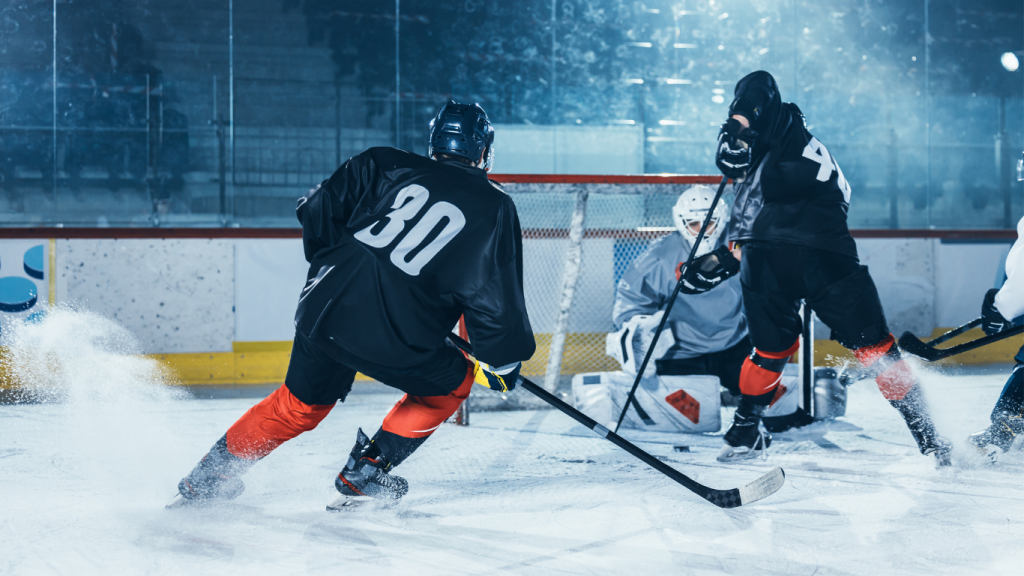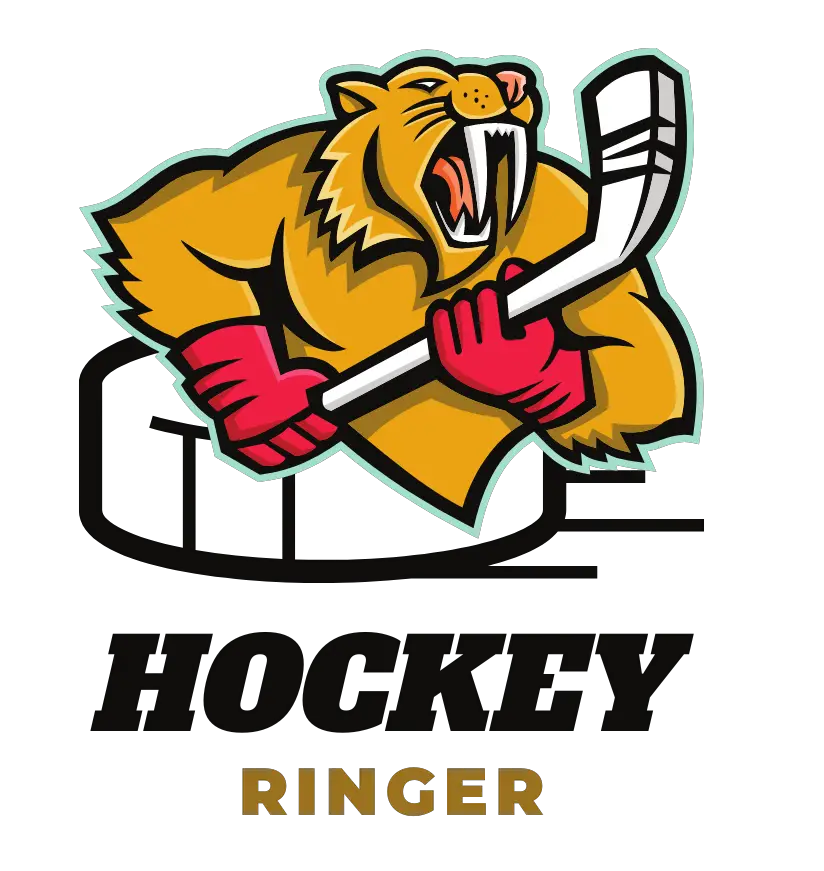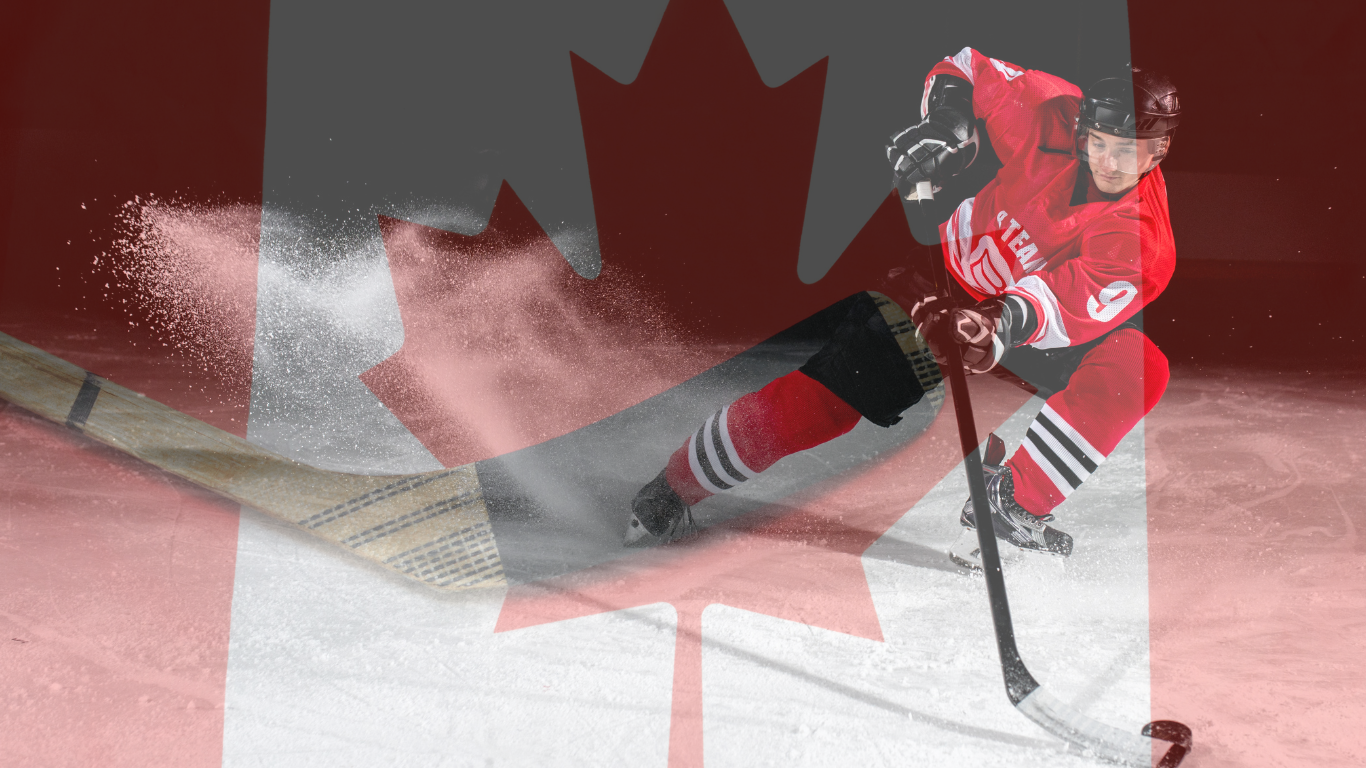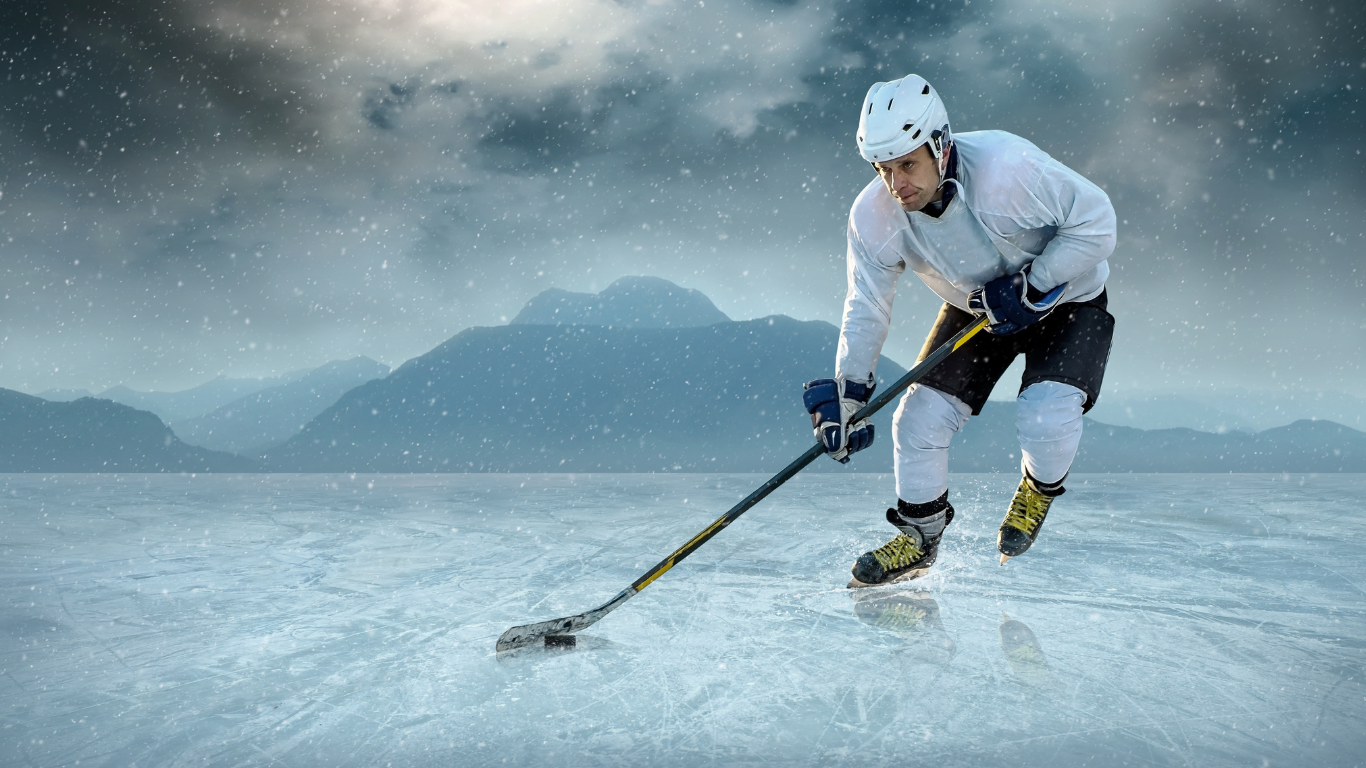Stickhandling in ice hockey is pivotal for optimal performance. To master it, begin with the correct grip: your top hand should lead in front, enabling a seamless movement of both the stick and puck. Control is key. It’s more than mere back-and-forth motions; you must practice maneuvering the puck from side to side, forward and backward.
Your top hand dominates in cradling the puck, so rolling your wrist is crucial. Ensure minimal space between the blade and puck for heightened control, and always keep your head and eyes up to make strategic plays.
Enhancing your stickhandling skills doesn’t stop on the ice. Create an office routine, incorporating obstacles and specific skills to diversify your practice. Incorporate stickhandling drills on and off the ice to refine your technique and puck control.
Basics of Stickhandling

The Importance of Stickhandling
Stickhandling is a crucial skill in ice hockey that allows players to maintain control of the puck while moving around the ice. It involves using the stick to maneuver the puck in various directions, allowing players to evade defenders and create scoring opportunities.
Tools for Stickhandling: Hockey Stick and Puck
To practice stickhandling, you will need a hockey stick and a puck. The stick should be the appropriate length for your height and should have a comfortable grip. The puck should be the standard size and weight for ice hockey.
Forehand and Backhand Stickhandling
There are two main types of stickhandling in ice hockey: forehand and backhand. Forehand stickhandling involves moving the puck with the stick’s blade while the player’s body faces the target. Backhand stickhandling involves moving the puck with the backside of the blade while the player’s body is facing away from the target.
The Role of Top Hand and Bottom Hand
The top hand and bottom hand play important roles in stickhandling. The top hand provides control and stability, while the bottom hand provides power and leverage. When stickhandling, it is important to have a balanced grip on the stick with both hands, allowing for maximum control and maneuverability.
| Tip |
|---|
| Practice stickhandling with both hands to become proficient in forehand and backhand stickhandling. |
Stickhandling is a fundamental skill in ice hockey that requires practice and dedication to master. By understanding the basics of stickhandling and utilizing proper techniques, players can improve their control of the puck and become more effective on the ice.
Mastering Stickhandling Techniques
Improving Puck Control
One of the most important aspects of stickhandling is maintaining control of the puck. To improve your puck control, it’s essential to practice with different types of pucks, such as weighted or lighter ones, and work on your hand positioning. Keep your hands close together and use your top hand to guide the stick while your bottom hand provides the power.
Keeping Your Head Up
It’s crucial to keep your head up while stickhandling to be aware of your surroundings. This will help you avoid collisions with other players and make better passes. Try stickhandling while keeping your eyes up and scanning the ice to practice this.
Dribbling and Fakes
Dribbling is an essential part of stickhandling, and it involves moving the puck back and forth in front of you. Fakes are also crucial to deceive the opponent and create space. Practice different types of fakes, such as the shoulder fake or the toe drag, to improve your dribbling skills.
Protecting the Puck
Protecting the puck is another essential aspect of stickhandling, especially in high-pressure situations. To protect the puck, keep your body between the puck and the opponent and use your free hand to fend off defenders.
Toe Drags
The toe drag is a popular stickhandling move that involves dragging the puck with the toe of your stick to change direction quickly. To execute a toe drag, move the puck to the backhand side of your stick, drag it across your body, and then pull it back to the forehand side.
By mastering these stickhandling techniques, you’ll be able to improve your control, dribbling, and fakes, protect the puck, and execute toe drags more effectively.
Stickhandling Drills and Exercises
Off-Ice Drills
Off-ice stickhandling drills are a great way to improve your stickhandling skills. These drills can be done anywhere, at any time, and with minimal equipment. Here are a few off-ice stickhandling drills that you can try:
- Stationary Stickhandling: Stand in one place and practice moving the puck around your body in different directions.
- Figure 8s: Move the puck around your feet in a figure 8 pattern.
- Toe Drag: Practice pulling the puck back towards your body using the toe of your stick.
On-Ice Drills
On-ice stickhandling drills are essential for improving your stickhandling skills in real-game situations. Here are a few on-ice stickhandling drills that you can try:
- Stationary Stickhandling: Move the puck around your body while standing in one place.
- Moving Stickhandling: Skate around the ice while moving the puck around your body.
- Obstacle Course: Set up cones or other obstacles on the ice and practice stickhandling around them.
Figure 8s
Figure 8s are a great way to improve your stickhandling skills. This drill involves moving the puck around your feet in a figure 8 pattern. Here’s how to do it:
- Start by standing with your feet shoulder-width apart and the puck in front of you.
- Move the puck around your left foot and then around your right foot, making a figure 8 pattern.
- Repeat the pattern several times, gradually increasing your speed.
Using a Weighted Ball
Using a weighted ball is an excellent way to improve your stickhandling skills. Here’s how to do it:
- Start by using a weighted ball slightly heavier than a regular puck.
- Practice moving the ball around your body in different directions, using the same techniques as a regular puck.
- Gradually increase the weight of the ball as your stickhandling skills improve.
Stickhandling is an essential skill for any ice hockey player. By practicing these drills and exercises, you can improve your stickhandling skills and become a more effective player on the ice.
Improving Stickhandling Skills
Increasing Speed and Quickness
To improve your stickhandling speed and quickness, you must focus on developing hand-eye coordination and reaction time. One way to do this is by incorporating drills requiring quick movements and direction changes.
Another way is to use a weighted stick or ball to increase the resistance and challenge your muscles.
Enhancing Precision and Range of Motion
You need to work on your wrist and forearm strength to enhance your stickhandling precision and range of motion.
You can do this by using a stickhandling ball or puck and practicing different techniques, such as toe drags and figure eights. You can also use a stickhandling aid, such as a stickhandling board, to improve your hand positioning and control.
Recovering from Mistakes
Mistakes are a natural part of learning and improving your stickhandling skills. To recover from mistakes, you need to stay focused and keep practicing. You can also use visualization techniques to rehearse different scenarios and prepare for unexpected situations mentally.
Taking Your Skills to the Next Level
To take your stickhandling skills to the next level, you must challenge yourself and keep pushing your limits. You can do this by practicing with faster and more skilled players, attending camps and clinics, and watching and learning from professional players.
The Role of Practice in Stickhandling
Starting Slow and Building Up
When it comes to stickhandling, practice is essential. It’s important to start slow and gradually build up your skills. Begin with basic drills and move on to more advanced ones as you improve. This will help you develop muscle memory and increase your confidence on the ice.
Maximizing Ice Time
You need to spend as much time as possible on the ice to improve your stickhandling. Take advantage of every opportunity to practice during team practices, open skating sessions, or private lessons. The more time you spend on the ice, the more comfortable you’ll become with the puck.
Using Space Effectively
When practicing stickhandling, it’s essential to use space effectively. Make sure you have enough room to move around and practice different moves. Use cones or other markers to create a practice area and work on your moves within that space.
Continuous Improvement and Progress
Stickhandling is a skill that requires continuous improvement and progress. Even after you’ve mastered basic drills, you should continue to practice and challenge yourself with more difficult ones. Keep track of your progress and set goals for yourself to stay motivated.
| Practice Tips |
|---|
| Start slow and build up |
| Maximize ice time |
| Use space effectively |
| Continuously improve and progress |
Stickhandling is a crucial skill in ice hockey, and it takes time and dedication to master it. By practicing regularly and following these tips, you can improve your stickhandling and become a more effective player.
Incorporating Stickhandling into the Game
Creating Scoring Opportunities
Stickhandling is an essential skill for creating scoring opportunities in ice hockey. You can confuse the opponent’s defense and create openings to shoot or pass by maneuvering the puck with your stick. To effectively stickhandle in a game, you need to move the puck quickly and accurately while keeping your head up to read the play.
Dealing with Opponents
When stickhandling in a game, you will often face opponents who are trying to take the puck away from you. To deal with opponents, you need to be able to protect the puck with your body and stick while maintaining your speed and agility. You can also use fakes and dekes to create space and get past defenders.
Making Successful Passes
Stickhandling is also important for making successful passes in a game. By controlling the puck with your stick, you can make accurate and timely passes to your teammates. It’s important to be aware of your surroundings and read the play to make the best pass possible.
Effective Dekes
Decking is a technique to get past opponents by tricking them with stickhandling. To deke effectively, you need to be able to change the direction of the puck while maintaining control quickly. Practicing different dekes and knowing when to use them in a game is important.
Incorporating stickhandling into your game can greatly improve your performance on the ice. By mastering this skill, you can create scoring opportunities, deal with opponents, make successful passes, and execute effective dekes.
Learning from the Pros
Observing NHL Players
One of the best ways to learn how to stickhandle in ice hockey is by observing NHL players. Watching professional players can help you understand how they move the puck, protect it from defenders, and create scoring opportunities. Pay attention to their body positioning, hand placement, and footwork. Try to replicate their movements during practice.
Training Videos and Coaching
Training videos and coaching can also be helpful in learning how to stickhandle. There are many training videos available online that can teach you the basics of stickhandling. You can also hire a coach to provide you with personalized training and feedback. Coaches can help you identify your weaknesses and provide you with drills to improve your stickhandling skills.
Learning from Professional Coaches
Learning from professional coaches can be a great way to improve your stickhandling skills. Professional coaches have experience working with NHL players and can provide you with valuable insights into the game. They can teach you advanced stickhandling techniques and provide you with personalized training to help you reach your full potential.
In conclusion, learning how to stickhandle in ice hockey takes time and practice. By observing NHL players, using training videos and coaching, and learning from professional coaches, you can improve your stickhandling skills and become a better player.
Frequently Asked Questions
What are some stickhandling drills for ice hockey?
There are many stickhandling drills that can help you improve your skills in ice hockey. Some of the most effective drills include the Figure Eight, Toe Drag, and the Windshield Wiper. These drills can help you improve your hand-eye coordination, speed, and control of the puck.
What are some common stickhandling moves in ice hockey?
There are several common stickhandling moves in ice hockey, including the Toe Drag, the Dangle, and the Spin-o-Rama. These moves can be used to get past defenders and create scoring opportunities.
How do you improve your stickhandling skills for ice hockey?
To improve your stickhandling skills for ice hockey, you should practice regularly and focus on developing your hand-eye coordination, speed, and control of the puck. You can also work on specific drills and exercises that target these areas.
What are some tips for effective stickhandling in ice hockey?
Some tips for effective stickhandling in ice hockey include keeping your head up, using your body to protect the puck, and practicing with both hands. You should also focus on developing your peripheral vision and anticipating the movements of your opponents.
How do you execute a successful deke in ice hockey?
To execute a successful deke in ice hockey, you should use your body to fake out the defender and create space for yourself. You can also use your stick to make quick, unexpected movements and change direction quickly.
What are some ways to practice stickhandling off the ice for ice hockey?
There are many ways to practice stickhandling off the ice for ice hockey, including using a stickhandling ball or puck, practicing with a stickhandling board, and working on your footwork and agility. You can also practice stickhandling while watching TV or listening to music to improve your focus and concentration.




Leave a Reply